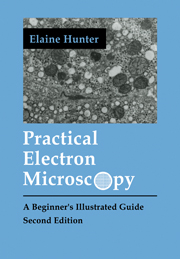Chapter 2 - Dehydration and Embedding
Published online by Cambridge University Press: 05 June 2012
Summary
INTRODUCTION
Following fixation, water must be removed from the tissue and replaced with a medium that will withstand the stress of cutting. Dehydration may be accomplished using either alcohol or acetone, and there are many support media (acrylics, polyesters, and epoxy resins) on the market. The methods outlined are for epoxy resins: Spurr's resin (Spurr, 1969), Epon (Kushida, 1959), and Epon-Araldite (Weakley, 1981).
It has been my experience that Spurr's resin, being the least viscous, is easiest to handle. Tissue penetration is good, and block hardness can be varied by increasing (softer) or decreasing (harder) the flexibilizer (DER). It is less hygroscopic than Epon or Araldite and cuts very easily. Spurr's resin is stable under the electron beam, but image contrast is lower than with Epon or Epon-Araldite and the toxicity of ERL 4206 is greater than any component in the other two resins.
Epon penetrates well; block hardness can be varied; and beam stability and image contrast are good. Epon-Araldite, although more viscous and therefore less easy to handle, penetrates well, cuts better than Epon or Araldite alone, and has good electronbeam stability and image contrast.
Specimens are dehydrated by immersion in a graded series of alcohol or acetone, using short periods to minimize shrinkage and other tissue damage. En bloc staining with heavy metals (to increase tissue contrast) can be done during dehydration and is recommended, especially if Spurr's resin is used. Several methods can be found in the literature, one of which will be given later (Kushida & Fujita, 1966).
- Type
- Chapter
- Information
- Practical Electron MicroscopyA Beginner's Illustrated Guide, pp. 17 - 30Publisher: Cambridge University PressPrint publication year: 1993

